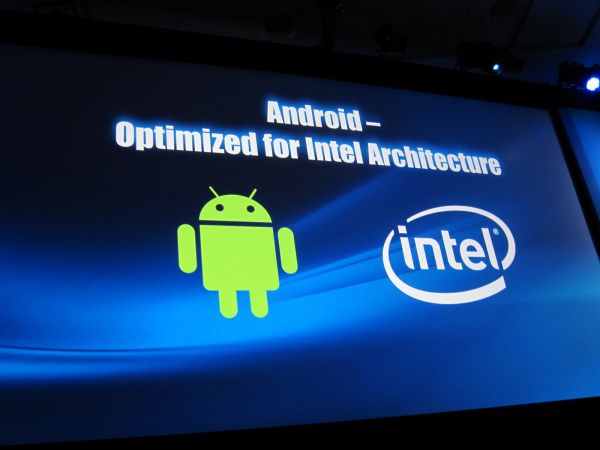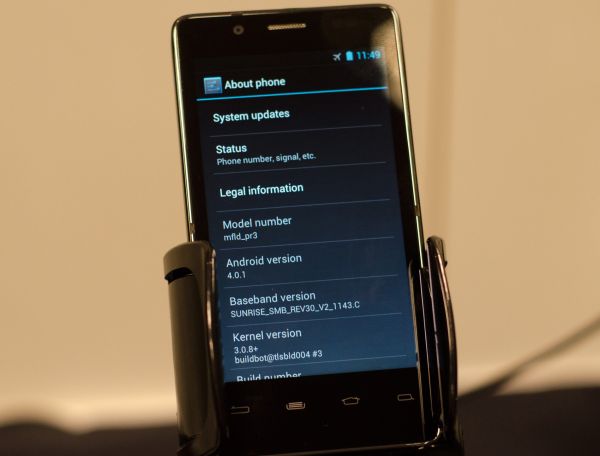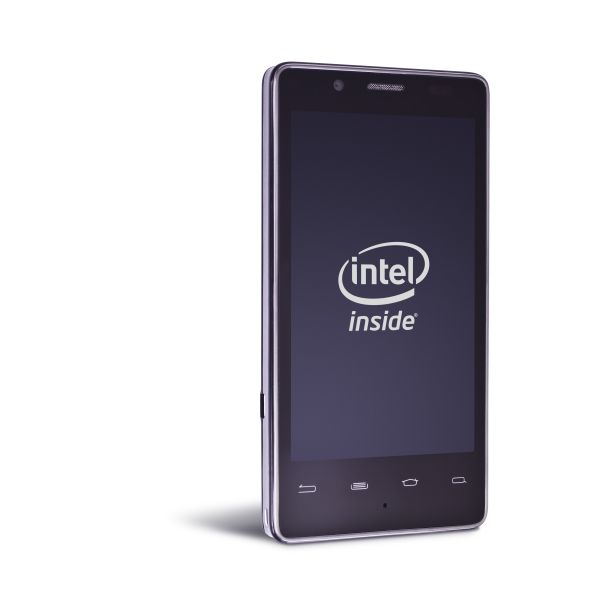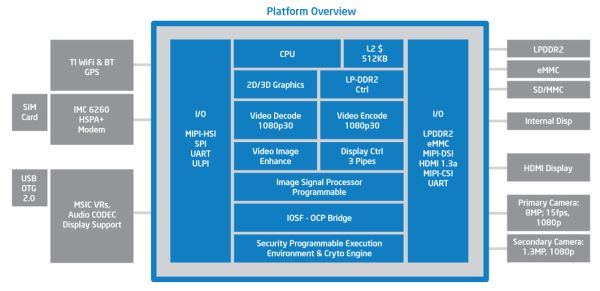Intel's Medfield & Atom Z2460 Arrive for Smartphones: It's Finally Here
by Anand Lal Shimpi on January 10, 2012 8:00 PM ESTWhat's Different This Time Around: Google & A Sweet Reference Platform
Intel has been talking about getting into smartphones for a couple of years now, but thus far it hasn't been able to secure a single design or partnership that that resulted in a product actually coming to market. This time around, things are different. The major change? Focus, and Google.
Intel originally had ambitions of enabling its own mobile OS with the help of Nokia (Moblin/MeeGo). Intel also wanted to support Android as well, however its attention was clearly more focused on the Moblin/MeeGo effort. Similar to the wake up call that pushed NVIDIA to focus exclusively on Android, Intel has now done the same.
At IDF last year Intel and Google announced a partnership and the intention to bring all future versions of Android, starting with Gingerbread, to x86. Since then Intel has ramped up the software engineering engine, going into the Android source code (Gingerbread, Honeycomb and now ICS) and fixing bugs. Intel's goal is to deliver the most stable version of Android as a result of its efforts. Intel is also submitting its changes upstream to the AOSP, which should help improve the Android experience even on ARM platforms.
Under the leadership of Mike Bell (formerly of Apple and Palm), Intel has also created an extremely polished Medfield reference design. This is the same design shown off at IDF last year (apparently there's an even thinner one floating around somewhere), but what separates it from other reference designs we've seen from SoC vendors is that the Medfield reference platform was designed to be a polished phone that could theoretically be rebranded and resold.
Intel knew the onus was on itself to prove that Medfield, Atom and even just x86 was power efficient enough to be delivered in a compelling form factor with competitive battery life. Paul Otellini gave Mike carte blanche access to any of Intel's resources. Instead of having to work with existing Intel groups, Mike was allowed to assemble his dream team of engineers. The team Mike built is what he felt he needed to not only bring Medfield to market, but also to build the a first class Atom based smartphone.
The result is this:
Internally it features Intel's own XMM 6260 HSPA+ modem. Intel claims LTE is on the way although there's no ETA on that.
WiFi in the reference design is provided by TI's 1283 controller. Intel's wireless team does not have a a WiFi solution that's low power enough to work in a smartphone, although after the recent restructuring the team has now been tasked with building an ultra low power solution that can.
The display is a somewhat unusual 1024 x 600 panel, with support for 1080p30 (and 1080i60) output via HDMI. The SoC specs are identical to what I've already discussed: 1.6GHz max CPU clock and a 400MHz GPU clock.
The reference platform is not only smartphone sized, but Intel has built its own qualification labs that mirror those of the carriers to ensure quality and convince its customers of the platform's legitimacy. In essence, Intel has built its own miniature smartphone design and test center.
The Medfield reference platform is available for use by any of Intel's customers, and indeed that's what's already happening. Lenovo's K800 is based on a modified version of Intel's reference platform, and I wouldn't be surprised if more aren't on the way.
All of this sounds a lot like Intel's efforts in the motherboard space over a decade ago where it started providing motherboard manufacturers with reference designs that they could modify if they desired. The effort helped significantly reduce time to market and allowed the motherboard makers to focus more on specializing on what they were good at.
The Medfield reference platform is designed to do the very same for smartphones. Intel wants to provide its partners with a well designed, stable smartphone platform. If they choose to use it, they can shave off a significant amount of development time and spend more of their time on software or simply bring a good reference phone to market in a quick fashion. I'm not entirely sure I've seen many players in the Android space that are actually all that great at software development, but Intel believes anything that shortens time to market will be appreciated.
I asked Intel if it has any plans to offer the reference platform unlocked, direct to customers. Unfortunately the answer at this point is still no. I suspect that Intel is more interested in building its customer base rather than circumventing it.
















164 Comments
View All Comments
janderk - Wednesday, January 11, 2012 - link
The numbers are still impressive, but there isn't such a thing as a stock Gingerbread browser performance.The Intel phone currently runs Android 2.3.7 in which browser performance is on par with Honeycomb/ICS. You can't compare those numbers with a S2 or Sensation running old Honeycomb versions. If you do, you are comparing Android versions more than hardware.
Google seems to have backported some browser code pieces to Gingerbread. A galaxy S2 on 2.3.6 with a stock ROM/browser scores around 90.000 in the Browsermark and around 2200 in the Spidermark. Ask Brian. He double checked and got even better numbers than I got.
Lucian Armasu - Wednesday, January 11, 2012 - link
That's a very good point. I wouldn't put it past Intel to "hype up" their marketing a little too much. I've been watching them very closely regarding this lately, and a lot of what they are saying is simply BS.Let's wait until we actually have the product in the market before we evangelize their yet to be seen chips.
Wilco1 - Wednesday, January 11, 2012 - link
While I like your article, you can't really conclude anything about micro archictures based on 2 micro benchmarks which have likely been highly tuned by Intel. Also note the Atom runs at 1.6GHz while the Nexus runs at 1.2GHz, so much of the performance difference is simply due to frequency.For a recent comparison between Cortex-A9 and Atom, check out these:
http://www.phoronix.com/scan.php?page=article&...
http://openbenchmarking.org/result/1201051-AR-1112...
In these 1.0 and 1.2GHz Cortex-A9 SoCs completely obliterates 1.6GHz netbook Atoms in performance on mostly single-threaded benchmarks. So in terms of micro architecture comparison, your article is dead wrong. When compared using same compiler and OS, the A9 beats Atom at a much lower frequency due to having higher IPC as a result of out-of-order execution. Note how it scores much higher on most memory benchmarks.
milli - Wednesday, January 11, 2012 - link
Actually the Z2460 runs at 1.3Ghz but can turbo to 1.6Ghz.Something might be up with the PandaBoard ES. Phoronix also has a Tegra 2 based review and that one also scores better on some tests than the PB-ES (just like the Exynos). The problem is that the scores are not really comparable because all three (PB-ES, T2, Exynos) use different compilers and kernels. Only the PB-ES uses the same compiler (and probably parameters) as the x86 systems. So you'll need to wait for real Medfield reviews when the time comes (or for Phoronix to do a better comparison). Especially the Exynos results need to be taken with a grain of salt since they used a total of three compilers there.
It's known that Atom's single threaded performance is bad. It has HyperThreading to cover that up. Since Android's JavaScript engine is multi-threaded, Atom performs well.
Wilco1 - Wednesday, January 11, 2012 - link
True, but you can bet Intel ensured the benchmarks were run at 1.6GHz, even if that wouldn't be feasible in a real phone due to cooling. So we have to wait for an actual phone with a standard Android version for the real comparison.There are indeed issues with the Panda board, the Ubuntu version used isn't compatible with the OMAP4460 so it isn't setup correctly. There are also compiler option issues and use of a slow flash card which reduces the scores. In terms of compilers used, GCC 4.5 or 4.6 doesn't make a major difference, so these benchmarks give a reasonable indication how Cortex-A9 would do vs Medfield.
If Android JavaScript is multithreaded, you'd expect a dual core A9 to do much better than Atom as you get a 100% speedup from the second core, not just 30% from hyperthreading. I suppose we'll see when the Intel improvements are added to the mainstream Android version.
Wilco1 - Wednesday, January 11, 2012 - link
True, but you can bet Intel ensured the benchmarks were run at 1.6GHz, even if that wouldn't be feasible in a real phone due to cooling. So we have to wait for an actual phone with a standard Android version for the real comparison.There are indeed issues with the Panda board, the Ubuntu version used isn't compatible with the OMAP4460 so it isn't setup correctly. There are also compiler option issues and use of a slow flash card which reduces the scores. In terms of compilers used, GCC 4.5 or 4.6 doesn't make a major difference, so these benchmarks give a reasonable indication how Cortex-A9 would do vs Medfield.
If Android JavaScript is multithreaded, you'd expect a dual core A9 to do much better than Atom as you get a 100% speedup from the second core, not just 30% from hyperthreading. I suppose we'll see when the Intel improvements are added to the mainstream Android version.
BSMonitor - Wednesday, January 11, 2012 - link
"If Android JavaScript is multithreaded, you'd expect a dual core A9 to do much better than Atom as you get a 100% speedup from the second core, not just 30% from hyperthreading. I suppose we'll see when the Intel improvements are added to the mainstream Android version. "No, you wouldn't get 100% speed bump because there are many more factors besides CPU resources that ultimately affect performance.
You are clearly a noob fanboy on a rant.
Wilco1 - Wednesday, January 11, 2012 - link
How much speedup you get obviously depends on lots of factors. However the fact remains that 2 cores have much more raw performance than 1 core with hyperthreading, so if JS is really multithreaded then the advantage would be to ARM, not Atom.virtual void - Thursday, January 12, 2012 - link
You have to keep, at least, two things in mind here1. The efficiency on the second HT in Atom is much higher than the 20-30% you see on Sandy Bridge. On Atom, 50-60% is probably a more accurate number based on a number of test I've done myself. And this is not because Atom in anyway is better than Sandy Bridge, it is quite the opposite. The in-order design and simple executions units in Atom will cause a lot more pipeline stalls which means that the other thread will get access to all the power (or lack of power) in the CPU.
2. You are that two physical cores has more raw power than two HT on the same core. But when you run a single program on two treads and work on the same data, HT has a huge benefit in that the two program threads will communicate via the L1 cache (shared between the HT) while two threads running on different physical cores will communicate via the L2 cache. The L1 cache has a much lower latency and much higher bandwidth compared to the L2 cache.
So HT can be very efficient in accelerating things where two threads are working on the same data-set. But two physical cores is probably always better when you have two threads running different programs or at least working on a data-set that is completely thread local.
Wilco1 - Thursday, January 12, 2012 - link
You're right if 2 threads belong to the same process and communicate a lot then HT has lower overheads, but the downside is that you quickly start trashing the small L1 caches. HT works better on Atom indeed, but 50-60% on average sounds a bit high, especially since Atom stalls on cachemisses.